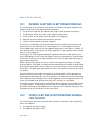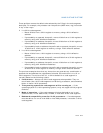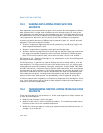
18-8 Vol. 3
MIXING 16-BIT AND 32-BIT CODE
segments can be modified to safely call procedures to 32-bit code segments in either
of two ways:
• Relink the CALL instruction to point to 32-bit call gates (see Section 18.4.2.2,
“Passing Parameters With a Gate”).
• Add a 32-bit operand-size prefix to each CALL instruction.
18.4.2.2 Passing Parameters With a Gate
When referencing 32-bit gates with 16-bit procedures, it is important to consider the
number of parameters passed in each procedure call. The count field of the gate
descriptor specifies the size of the parameter string to copy from the current stack to
the stack of a more privileged (numerically lower privilege level) procedure. The
count field of a 16-bit gate specifies the number of 16-bit words to be copied,
whereas the count field of a 32-bit gate specifies the number of 32-bit doublewords
to be copied. The count field for a 32-bit gate must thus be half the size of the
number of words being placed on the stack by a 16-bit procedure. Also, the 16-bit
procedure must use an even number of words as parameters.
18.4.3 Interrupt Control Transfers
A program-control transfer caused by an exception or interrupt is always carried out
through an interrupt or trap gate (located in the IDT). Here, the type of the gate
(16-bit or 32-bit) determines the operand-size attribute used in the implicit call to
the exception or interrupt handler procedure in another code segment.
A 32-bit interrupt or trap gate provides a safe interface to a 32-bit exception or inter-
rupt handler when the exception or interrupt occurs in either a 32-bit or a 16-bit code
segment. It is sometimes impractical, however, to place exception or interrupt
handlers in 16-bit code segments, because only 16-bit return addresses are saved on
the stack. If an exception or interrupt occurs in a 32-bit code segment when the EIP
was greater than FFFFH, the 16-bit handler procedure cannot provide the correct
return address.
18.4.4 Parameter Translation
When segment offsets or pointers (which contain segment offsets) are passed as
parameters between 16-bit and 32-bit procedures, some translation is required. If a
32-bit procedure passes a pointer to data located beyond 64 KBytes to a 16-bit
procedure, the 16-bit procedure cannot use it. Except for this limitation, interface
code can perform any format conversion between 32-bit and 16-bit pointers that
may be needed.
Parameters passed by value between 32-bit and 16-bit code also may require trans-
lation between 32-bit and 16-bit formats. The form of the translation is application-
dependent.


















